Traditional Japanese Food // 10 Of The Very Best (You Have To Try)
Japanese Food You Cannot Go Without 🍣 Our Top Ten
We’ve been looking forward to writing this one. Traditional Japanese Food! Is there a better cuisine in the world (sorry Italians)?!

Japanese Food is far more than just Sushi, so much more.
The fact there are many dishes that fly under the radar worldwide only adds to the fun because there is just so much to discover!
Today we are going to introduce you to 10 of the very best traditional Japanese foods!
Japan has got you covered with numerous traditional and healthy foods! You might find some of them in your nearest Konbini.
Traditional Japanese Food #1 | Sushi (すし, 寿司, 鮨, 鮓)
Traditional Japanese Food #2 | Miso Soup (味噌汁)
Traditional Japanese Food #3 | Ramen (ラーメン)
Traditional Japanese Food #4 | Soba (そば) and Udon (うどん)
Traditional Japanese Food #5 | Onigiri (お握り)
Traditional Japanese Food #6 | Tempura (天ぷら)
Traditional Japanese Food #7 | Yakitori (焼き鳥)
Traditional Japanese Food #8 | Sukiyaki (すき焼き)
Traditional Japanese Food #9 | Okonomiyaki (お好み焼き)
Traditional Japanese Food #10 | Natto (納豆)
BONUS | Wagashi (和菓子)
Traditional Japanese Food | FAQ’s

Traditional Japanese Food #1 | Sushi (すし, 寿司, 鮨, 鮓)
When you think about traditional Japanese food, the first food that comes to mind is of course Sushi!
Sushi is a traditional Japanese dish of prepared vinegared rice, known as 鮨饭 (sushi meshi). This is usually accompanied with some sugar, salt and a variety of ingredients such as seafood, often raw, and vegetables.
See more here.
Chirashizushi is eaten annually on Hinamatsuri in March and Kodomonohi in May.
Makizushi, is generally wrapped in nori, but is occasionally wrapped in a thin omelette, soy paper, cucumber, or shiso leaves.
This is the sushi that most people know and love!
Here are a couple of pictures below to bring both of these types of sushi to life!
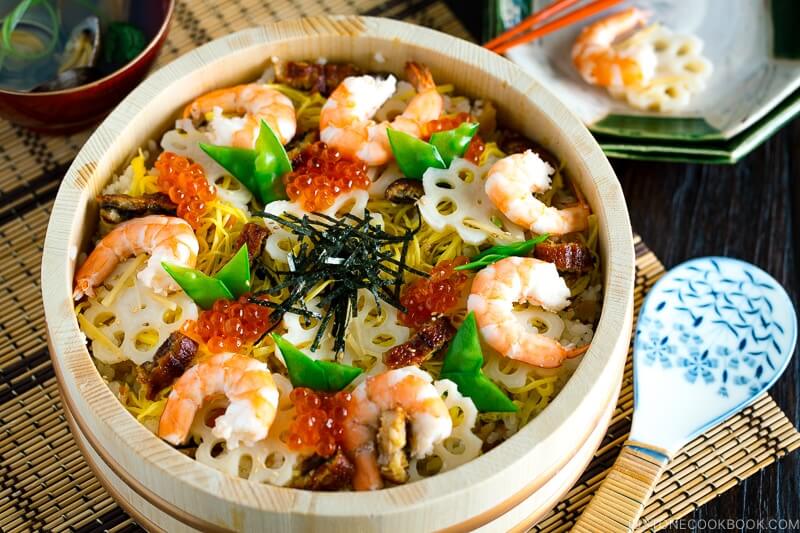

Traditional Japanese Food #2 | Miso Soup (味噌汁)
Miso soup is also called Omiotsuke.
It is a traditional Japanese soup consisting of a dashi stock into which softened miso paste is mixed along with many optional ingredients.
More than 80% of Japan’s annual production of miso is used in miso soup.
FUN FACT | 75% of all Japanese people consume miso soup at least once a day.
In 2003, researchers at Japan’s National Cancer Centre suggested that “eating three or more bowls of the Japanese delicacy Miso soup every day could cut women’s risk of developing breast cancer”.

Express Your Love 💖 How to Say I Love You in Japanese
Today we open our hearts and teach you how to express you love in Japanese – welcome to our guide on how to say I love you in Japanese.
Traditional Japanese Food #3 | Ramen (ラーメン)
If you’ve watched Naruto, you definitely know Ramen! In fact, surely you all know Ramen, right?
One of Japan’s most scrumptious dishes that comes in so many flavours and forms!
ラーメン consists of Chinese-style wheat noodles served in a meat or fish-based broth, often flavoured with soy sauce or miso, and uses toppings such as sliced pork, nori, menma, and scallions.
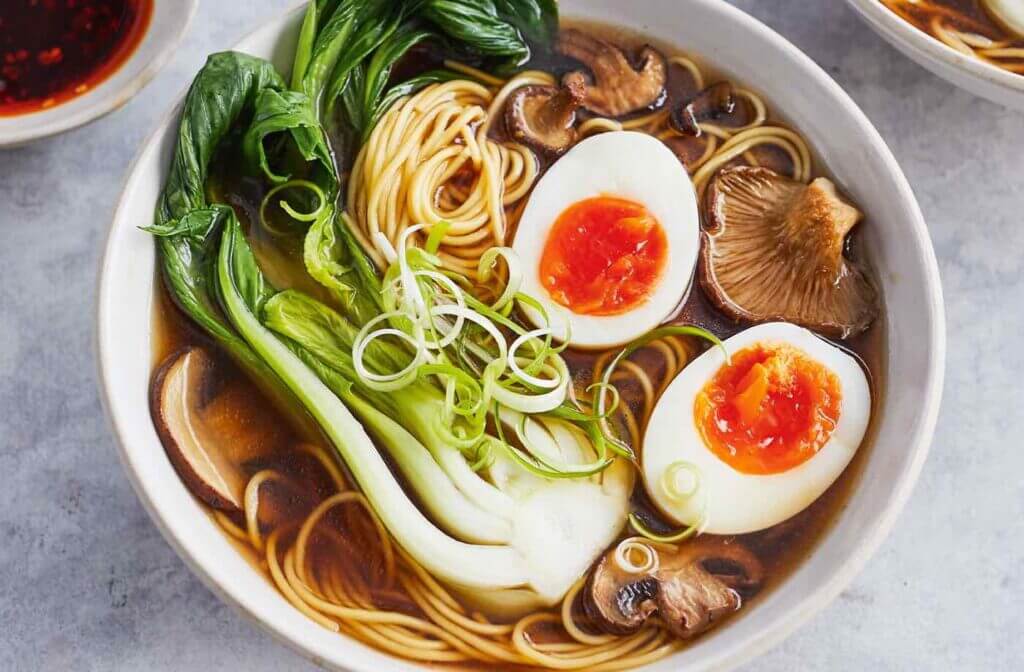
Seasonings commonly added to ramen are white pepper, black pepper, butter, chilli pepper, sesame seeds, and crushed garlic.
Don’t forget to visit Shin-Yokohama Ramen Museum in Yokohama next time you visit Japan!
BONUS | Ramen comes in many forms and one of our absolute favourites is known as TSUKEMEN.
These are dipping noodles that come with two bowls – one with your ingredients and one with a broth.
Dip those noodles into the broth and slurp up that unique flavour.
Incredibly enough one of the most popular places to get Tsukemen is inside the Japanese Underground! No joke, just be sure to head to Tokyo Train station!
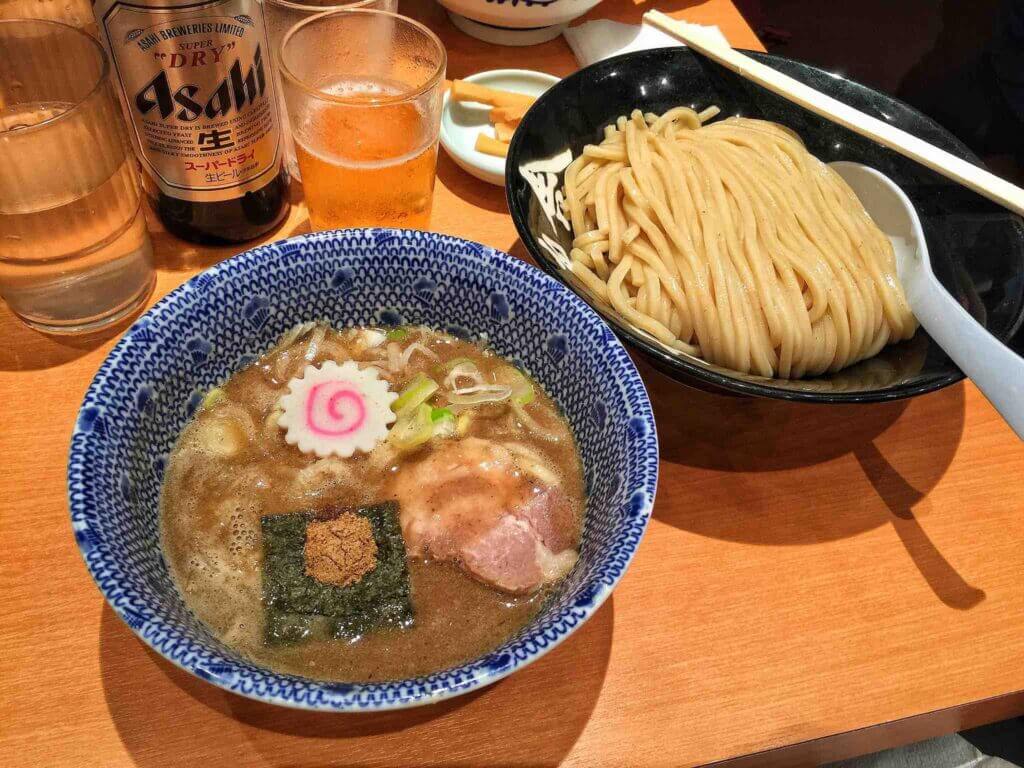
Traditional Japanese Food #4 | Soba (そば) and Udon (うどん)
Soba and Udon are types of Japanese noodles.
You can have these delicacies on hot summer days as well as cold winter nights!
Soba is often served drained and chilled in the summer, and hot in the winter with a soy-based dashi broth.
Shinshu Soba of Nagano Prefecture are very famous in Japan.
Udon is a comfort food for many Japanese people.
It is often used in “shabu shabu” or Japanese hot pot.
Sanuki udon of Kagawa prefecture are also well-known in Japan.

So how do they differ exactly?
Well firstly you can see the colour is completely different in the picture. Udon noodles tend to be thicker in general also.
The flour that is used to make these noodles is a big reason for this.
“Udon uses wheat flour for that dense and dreamy thick finish and chewy texture whereas Soba celebrates buckwheat flour with its slightly grainier texture.”
Source here
Taste wise, Soba are a little nuttier than Udon meaning they are best served with lighter dishes so the flavour is not too overpowering.
Traditional Japanese Food #5 | Onigiri (お握り)
A classic choice as a snack or quick meal!
Onigiri could be found in most Japanese convenience stores with a wide range of fillings and flavours to select from.
Traditionally, an onigiri is filled with pickled ume (umeboshi), salted salmon, katsuobushi or any other salty or sour ingredient as a natural preservative.
Onigiri Asakusa Yadoroku in Tokyo is a restaurant that has received a Michelin star for its exquisite rice balls.
You can check out their website here to find out more.

Traditional Japanese Food #6 | Tempura (天ぷら)
If you love deep fried food, Tempura will definitely satisfy your tastebuds!
It consists of seafood, meat and vegetables that have been battered and deep fried.
It is commonly served with grated daikon and eaten hot immediately after frying.
Tempura is a popular sharing dish and comes in many shapes and sizes. A proper fans’ favourite in Japan and with foreigners alike.
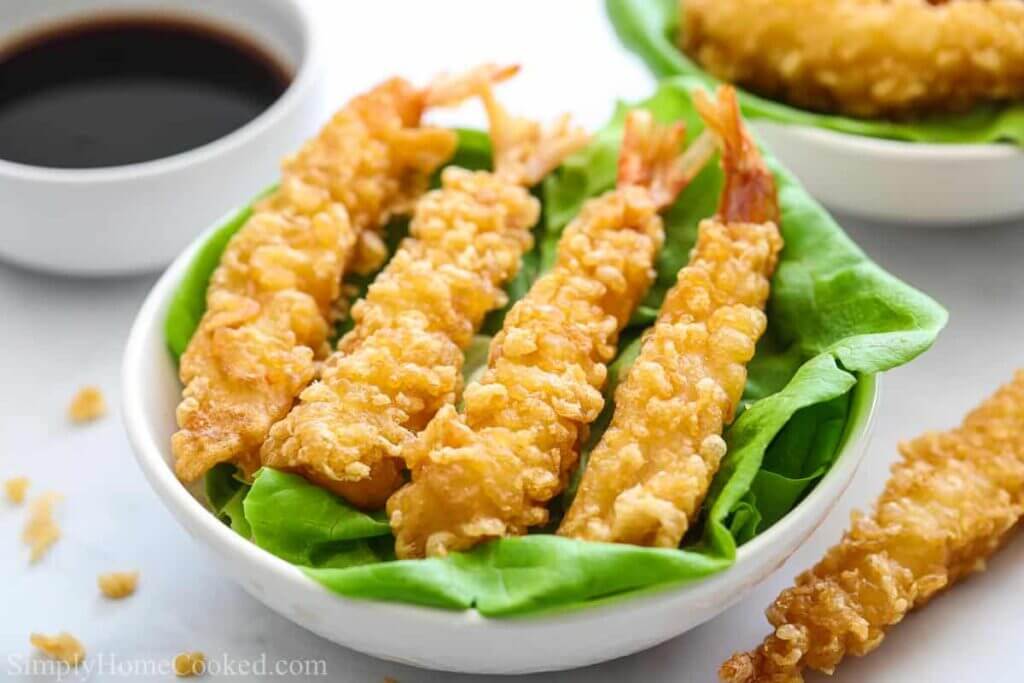
Traditional Japanese Food #7 | Yakitori (焼き鳥)
Yakitori is a type of skewered chicken.
In fact, 焼き鳥 may well take the first rank for the most popular street food in Japan!
Often sold from small carts and stalls known as yatai, they are found dotted in streets during festivals or busy routes during the evening commute where customers can enjoy beer and sake with yakitori.
Easy to eat on the move, this is another fans’ favourite that you simply have to try in Japan.

Things Not to Do in Japan 🙅♀️ Guide to Japanese Etiquette
Things Not to Do in Japan 🇯🇵 The ULTIMATE list of DON’Ts for your time in Japan and how to maintain perfect Japanese Etiquette
Traditional Japanese Food #8 | Sukiyaki (すき焼き)
Are you a hot pot fan? Then here comes the Japanese version of hot pot which is called すき焼き.
Sukiyaki usually consists of thinly sliced beef which is slowly cooked or simmered at the table, alongside vegetables and other ingredients in a shallow iron pot in a mixture of soy sauce, sugar, and mirin.
Generally, すき焼き is a winter dish and it is commonly found at Japanese year-end parties.
Sukiyaki, as with most hotpots, are full of different colours and flavours and provides a brilliantly social way to get to know people.
Going for sukiyaki is a great way to make new Japanese friends or get to know your new colleagues.

See what a Chinese hot pot looks like right here!
Traditional Japanese Food #9 | Okonomiyaki (お好み焼き)
Now here is a Japanese gem that flies right under the radar. A dish so criminally underrated we can hard believe our eyes.
Get ready for a taste sensation like never before. It’s the beautiful and colour お好み焼き.
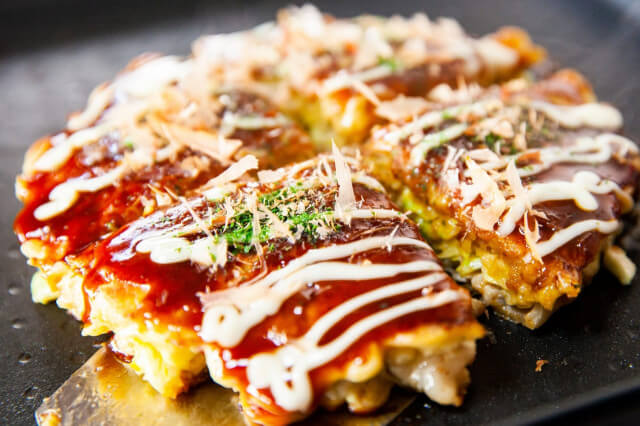
Okonomiyaki is a Japanese savoury pancake dish consisting of wheat flour batter and other ingredients cooked on a teppan (flat griddle), so famously seen in Japanese cooking.
Many of the street vendors and shops prepare it “cooked how you like it“, using whatever ingredients you like.
You’ve got many options to choose from to satisfy your picky needs!
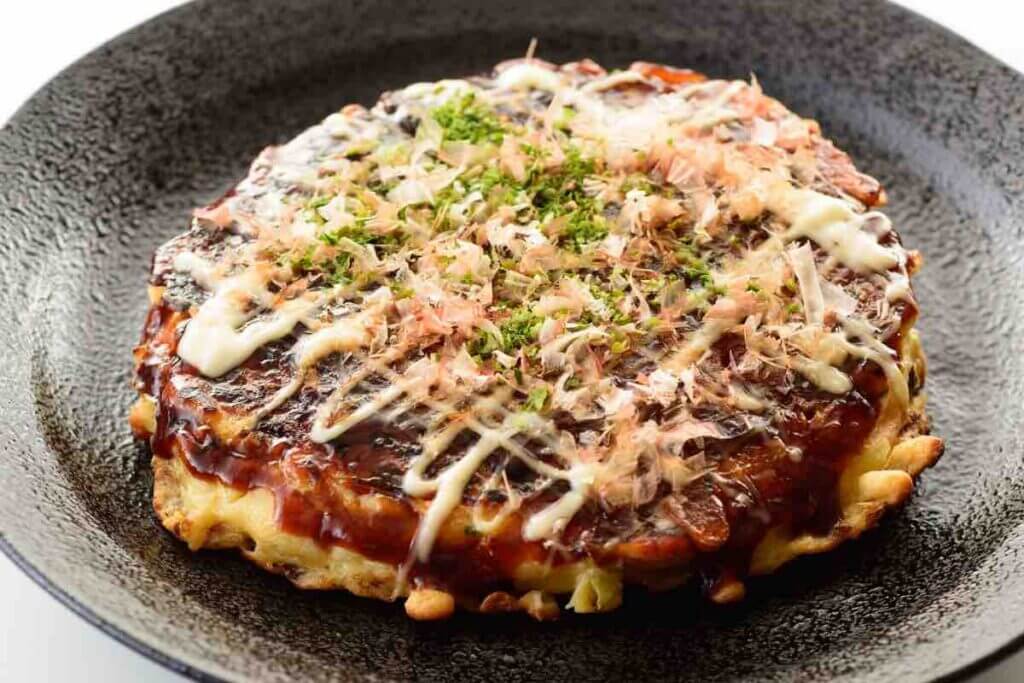
Common additions include:
- Cabbage
- Meat
- Seafood
- Sauce
- Pickled ginger
… and a whole lot more.
Hunt this down when coming to Japan, as soon as you land in fact!
Traditional Japanese Food #10 | Natto (納豆)
Here is a super healthy and nutritious Japanese food!
It is made from soybeans that have been fermented.
Natto has a distinctive odour, somewhat akin to a pungent aged cheese, strong flavour, and a sticky, slimy texture.
Doesn’t sound super appealing at first does it, but stay with us (remember Gorgonzola cheese smells pretty pungent but that didn’t hold back it’s popularity).

Natto though, is often considered an acquired taste.
A 2009 Internet survey in Japan indicated 70% of respondents like nattō and 30% do not, but about half of those who dislike nattō eat it for its health benefits.

Time in Japanese // Days, Weeks, Months & Seasons (With FREE Quiz)
Time in Japanese // We’ll teach you how easy it is to learn the months in Japanese, the different seasons and times of the day.
BONUS TIME! Ready for a Traditional Japanese dessert !
Traditional Japanese Food BONUS | Wagashi (和菓子)
The most authentic way to finish off a Japanese meal or matcha tea ceremony is with Wagashi.
They are typically made from plant-based ingredients, including mochi rice cakes, anko paste, kanten, chestnuts and sugar.
Wagashi are used as a gift during festivals, or while visiting guests.
Japanese people tend to take back home wagashi after business trips or personal trips as they are known for their delicateness and variety in appearance, reflecting the delicacy culture of Japan.

BIG FAN OF FOOD? Aren’t we all?
Then you won’t want to miss these too!
- Discover the best Chinese dishes, some of these WILL surprise you!
- Find out the best foods you can find on the streets of Vietnam.
- Some of Korea’s finest food
- 14 delightful Russian dishes to experience
Traditional Japanese Food FAQs
How do you spell Yakitori in Japanese characters?
Yakitori is 焼き鳥.
Look out for this in street markets!
What can I have in an Okonomiyaki?
Plenty of things, they are jam packed with many ingredients and amazing flavours!
Common additions include:
Cabbage
Meat
Seafood
Sauce
Pickled ginger
Do Japanese people really like Natto?
A 2009 Internet survey in Japan indicated 70% of respondents like nattō and 30% do not, but about half of those who dislike nattō eat it for its health benefits.
What is Wagashi?
It is a typical Japanese dessert.
Wagashi is the most authentic way to finish off a Japanese meal or matcha tea ceremony.
They are typically made from plant-based ingredients, including mochi rice cakes, anko paste, kanten, chestnuts and sugar.
Wagashi are used as a gift during festivals, or while visiting guests.
Japanese people tend to take back home wagashi after business trips or personal trips as they are known for their delicateness and variety in appearance, reflecting the delicacy culture of Japan.
Want More From LTL?
WANT TO LEARN JAPANESE? Check out our online Japanese courses here.
We offer a 7-day free trial to all new students where you can study 24/7.
What about studying Japanese in Japan instead? We’ve got your back. Our Japanese courses in Tokyo can either be taken in small groups of no more than 5 students or individually for a more tailored experience.
We even offer incredible homestay experiences in Tokyo as well.
Come and be a part of this amazing community.










2 comments
Nothing beats Ramen on a cold day
You couldn't be more right Corey!